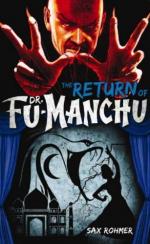“Your practical mind naturally seeks a practical explanation,” smiled Van Roon, “but I myself have other theories. Then in addition to the charms of Sedgemoor—haunted Sedgemoor—on a fine day it is quite possible to see the ruins of Glastonbury Abbey from here; and Glastonbury Abbey, as you may know, is closely bound up with the history of alchemy. It was in the ruins of Glastonbury Abbey that the adept Kelly, companion of Dr. Dee, discovered, in the reign of Elizabeth, the famous caskets of St. Dunstan, containing the two tinctures . . .”
So he ran on, enumerating the odd charms of his residence, charms which for my part I did not find appealing. Finally:
“We cannot presume further upon your kindness,” said Nayland Smith, standing up. “No doubt we can amuse ourselves in the neighborhood of the house until the return of your servant.”
“Look upon Cragmire Tower as your own, gentlemen!” cried Van Roon. “Most of the rooms are unfurnished, and the garden is a wilderness, but the structure of the brickwork in the tower may interest you archaeologically, and the view across the moor is at least as fine as any in the neighborhood.”
So, with his brilliant smile and a gesture of one thin yellow hand, the crippled traveler made us free of his odd dwelling. As I passed out from the room close at Smith’s heels, I glanced back, I cannot say why. Van Roon already was bending over his papers, in his green shadowed sanctuary, and the light shining down upon his smoked glasses created the odd illusion that he was looking over the tops of the lenses and not down at the table as his attitude suggested. However, it was probably ascribable to the weird chiaroscuro of the scene, although it gave the seated figure an oddly malignant appearance, and I passed out through the utter darkness of the outer room to the front door. Smith opening it, I was conscious of surprise to find dusk come—to meet darkness where I had looked for sunlight.
The silver wisps which had raced along the horizon, as we came to Cragmire Tower, had been harbingers of other and heavier banks. A stormy sunset smeared crimson streaks across the skyline, where a great range of clouds, like the oily smoke of a city burning, was banked, mountain topping mountain, and lighted from below by this angry red. As we came down the steps and out by the gate, I turned and looked across the moor behind us. A sort of reflection from this distant blaze encrimsoned the whole landscape. The inland bay glowed sullenly, as if internal fires and not reflected light were at work; a scene both wild and majestic.
Nayland Smith was staring up at the cone-like top of the ancient tower in a curious, speculative fashion. Under the influence of our host’s conversation I had forgotten the reasonless dread which had touched me at the moment of our arrival, but now, with the red light blazing over Sedgemoor, as if in memory of the blood which had been shed there, and with the tower of unknown origin looming above me, I became very uncomfortable again, nor did I envy Van Roon his eerie residence. The proximity of a tower of any kind, at night, makes in some inexplicable way for awe, and to-night there were other agents, too.




